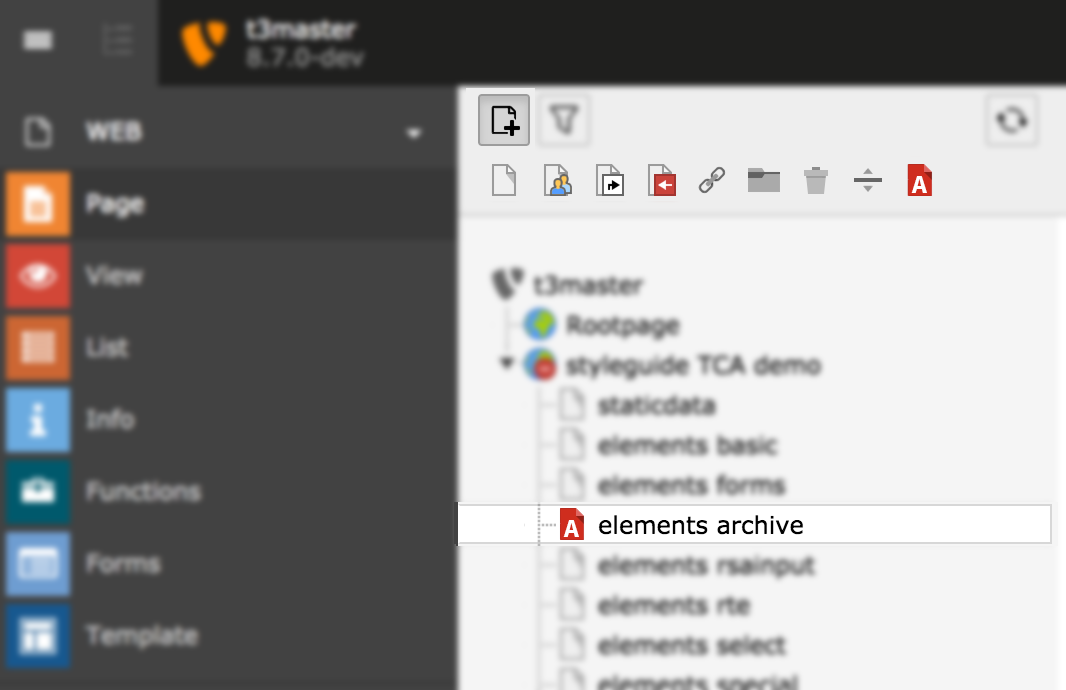Attention
TYPO3 v10 has reached end-of-life as of April 30th 2023 and is no longer being maintained. Use the version switcher on the top left of this page to select documentation for a supported version of TYPO3.
Need more time before upgrading? You can purchase Extended Long Term Support (ELTS) for TYPO3 v10 here: TYPO3 ELTS.
Page Types¶
The $GLOBALS['PAGE_TYPES'] Array¶
Global array $GLOBALS['PAGES_TYPES'] defines the various types of pages (field: doktype) the
system can handle and what restrictions may apply to them. Here you can define which tables are
allowed on a certain page type.
Note
The "default" entry in the $GLOBALS['PAGES_TYPES'] array is the "base"
for all types, and for every type the entries simply overrides the
entries in the "default" type!!
This is the default array as set in EXT:core/ext_tables.php:
$GLOBALS['PAGES_TYPES'] = [
(string)\TYPO3\CMS\Core\Domain\Repository\PageRepository::DOKTYPE_BE_USER_SECTION => [
'allowedTables' => '*'
],
(string)\TYPO3\CMS\Core\Domain\Repository\PageRepository::DOKTYPE_SYSFOLDER => [
// Doktype 254 is a 'Folder' - a general purpose storage folder for whatever you like.
// In CMS context it's NOT a viewable page. Can contain any element.
'allowedTables' => '*'
],
(string)\TYPO3\CMS\Core\Domain\Repository\PageRepository::DOKTYPE_RECYCLER => [
// Doktype 255 is a recycle-bin.
'allowedTables' => '*'
],
'default' => [
'allowedTables' => 'pages,sys_category,sys_file_reference,sys_file_collection',
'onlyAllowedTables' => false
],
];
The key used in the array above is the value that will be stored in the
doktype field of the "pages" table.
Tip
As for other $GLOBALS values, you can view current settings in the
backend in System > Configuration (with installed lowlevel
system extension).
Note
In TYPO3 versions below 10.4, the doktype was restricted to numbers
smaller than 200 if the custom page type should be displayed in the
frontend, and larger than 200 when it is just some storage. This limitation
no longer exists, so you can choose a number at will.
Each array has the following options available:
Key |
Description |
|---|---|
type |
Can be "sys" or "web". This is purely informative, as TYPO3 CMS does nothing with that piece of data. |
allowedTables |
The tables that may reside on pages with that "doktype". Comma-separated list of tables allowed on this page doktype. "*" = all. |
onlyAllowedTables |
Boolean. If set to true, changing the page type will be blocked if the chosen page type contains records that it would not allow. |
Note
The options allowedTables and onlyAllowedTables must be set
for the default type while the rest can choose as they like.
Types of Pages¶
TYPO3 has predefined a number of pages types as constants in
typo3/sysext/core/Classes/Domain/Repository/PageRepository.php.
What role each page type plays and when to use it is explained in more detail in Page types. Some of the page types require additional fields in pages to be filled out:
DOKTYPE_DEFAULTStandard
DOKTYPE_LINKLink to External URL
This type of page creates a redirect to an URL in the frontend. The URL is specified in the field
pages.url.DOKTYPE_SHORTCUTShortcut
This type of page creates a redirect to another page in the frontend. The shortcut target is specified in the field
pages.shortcut, shortcut mode is stored inpages.shortcut_mode.DOKTYPE_BE_USER_SECTIONBackend User Section
DOKTYPE_MOUNTPOINTMount point
The mounted page is specified in
pages.mount_pid, while display options can be changed withpages.mount_pid_ol.DOKTYPE_SPACERMenu separator
DOKTYPE_SYSFOLDERFolder
DOKTYPE_RECYCLERRecycler
Create new Page Type¶
The following example adds a new page type called "Archive".

The new page type visible in the TYPO3 backend¶
The whole code to add a page type is shown below with the according file names above.
The first step is to add the new page type to the global array described above. Then you need to add the icon chosen for the new page type and allow users to drag and drop the new page type to the page tree.
Note
You have to change example in the argument of the anonymous function
to your own extension key.
The new page type is added to $GLOBALS['PAGES_TYPES'] in ext_tables.php:
(function ($extKey='example') {
$archiveDoktype = 116;
// Add new page type:
$GLOBALS['PAGES_TYPES'][$archiveDoktype] = [
'type' => 'web',
'allowedTables' => '*',
];
})();
User TSconfig is added and an icon is registed in ext_localconf.php:
(function ($extKey='example') {
$archiveDoktype = 116;
// Provide icon for page tree, list view, ... :
$iconRegistry = \TYPO3\CMS\Core\Utility\GeneralUtility::makeInstance(\TYPO3\CMS\Core\Imaging\IconRegistry::class);
$iconRegistry
->registerIcon(
'apps-pagetree-archive',
TYPO3\CMS\Core\Imaging\IconProvider\SvgIconProvider::class,
[
'source' => 'EXT:' . $extKey . '/Resources/Public/Icons/Archive.svg',
]
);
$iconRegistry
->registerIcon(
'apps-pagetree-archive-contentFromPid',
TYPO3\CMS\Core\Imaging\IconProvider\SvgIconProvider::class,
[
'source' => 'EXT:' . $extKey . '/Resources/Public/Icons/ArchiveContentFromPid.svg',
]
);
// ... register other icons in the same way, see below.
// Allow backend users to drag and drop the new page type:
\TYPO3\CMS\Core\Utility\ExtensionManagementUtility::addUserTSConfig(
'options.pageTree.doktypesToShowInNewPageDragArea := addToList(' . $archiveDoktype . ')'
);
})();
Furthermore we need to modify the configuration of "pages" records. As one can modify the pages, we
need to add the new doktype as select item and associate it with the configured icon. That's done in
Configuration/TCA/Overrides/pages.php:
(function ($extKey='example', $table='pages') {
$archiveDoktype = 116;
// Add new page type as possible select item:
\TYPO3\CMS\Core\Utility\ExtensionManagementUtility::addTcaSelectItem(
$table,
'doktype',
[
'LLL:EXT:' . $extKey . '/Resources/Private/Language/locallang.xlf:archive_page_type',
$archiveDoktype,
'EXT:' . $extKey . '/Resources/Public/Icons/Archive.svg'
],
'1',
'after'
);
\TYPO3\CMS\Core\Utility\ArrayUtility::mergeRecursiveWithOverrule(
$GLOBALS['TCA'][$table],
[
// add icon for new page type:
'ctrl' => [
'typeicon_classes' => [
$archiveDoktype => 'apps-pagetree-archive',
$archiveDoktype . '-contentFromPid' => "apps-pagetree-archive-contentFromPid",
$archiveDoktype . '-root' => "apps-pagetree-archive-root",
$archiveDoktype . '-hideinmenu' => "apps-pagetree-archive-hideinmenu",
],
],
// add all page standard fields and tabs to your new page type
'types' => [
(string) $archiveDoktype => [
'showitem' => $GLOBALS['TCA'][$table]['types'][\TYPO3\CMS\Core\Domain\Repository\PageRepository::DOKTYPE_DEFAULT]['showitem']
]
]
]
);
})();
As you can see from the example, to make sure you get the correct icons, you can utilize typeicon_classes.
For the following cases you need to configure icons explicitly, otherwise they will automatically fall back to the variant for regular page doktypes.
Page contains content from another page (
<doktype>-contentFromPid)Page is hidden in navigation (
<doktype>-hideinmenu)Page is site-root (
<doktype>-root)
Note
Make sure to add the additional icons using the icon registry!
